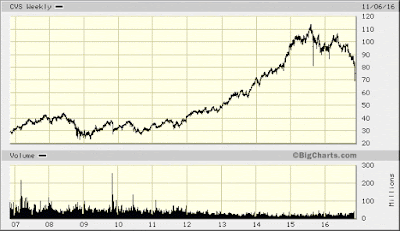CVS Health Corp (NYSE:CVS), together with its subsidiaries, provides integrated pharmacy health care services. It operates through Pharmacy Services and Retail/LTC segments. The Pharmacy Services Segment provides a range of pharmacy benefit management (PBM) solutions.
The Retail Pharmacy segment includes retail drugstores, online retail pharmacy Websites and its retail healthcare clinics. This dividend achiever has paid a dividend since 1916 and increased it for 13 years in a row.

racorn/Shutterstock.com
The most recent dividend increase was in December 2015, when the Board of Directors approved a 21.40 cent increase (1) in the quarterly dividend to 42.50 cents/share. The largest competitors for Walgreen include Walgreen Boots Alliance (NYSE:WBA), Wal-Mart (NYSE:WMT) and Rite-Aid (NYSE:RAD).
Over the past decade this dividend growth stock (2) has delivered an annualized total return of 11.40% to its shareholders. Future returns will be dependent on growth in earnings and dividend yields obtained by shareholders.
The company has managed to deliver a 12.30% average increase in annual EPS over the past decade. CVS Health is expected to earn $5.85 per share in 2016 and $6.10 per share in 2017. In comparison, the company earned $4.62/share in 2015.
Between 2008 and 2016 CVS Health has been able to reduce the number of shares from 1.469 billion to 1.073 billion through consistent share buybacks.
Growth in earnings per share could be driven by acquisitions and share buybacks. For example, the company acquired Target Corporation (NYSE:TGT) pharmacies (3) last year. In addition, CVS acquired Omnicare in 2015. Omnicare is a prescription drug and service provider to the long-term health and specialty healthcare industries. International expansion could also be on the horizon. For example, CVS acquired Brazilian company named Drogaria Onofre in 2013.
The company fills more than 1.30 billion prescriptions per year, in its more than 9600 locations in the US. This provides significant scale for CVS, a competitive advantage, which reduces cost per prescription. Pharmacy prescriptions account for over 70% of sales per year. Third parties pay for almost the whole prescription amounts. In addition, the company is able to obtain cost advantages, by getting preferential pricing from suppliers. Payers utilize services of Pharma Benefits Managers such as CVS, in order to control costs – the scale in claims processing and preferential pricing with suppliers is definitely a plus there.
CVS also health clinics, and is expected to reach 1,500 of them by 2017.
Follow Cvs Health Corp (NYSE:CVS)
Follow Cvs Health Corp (NYSE:CVS)
Long term demand for healthcare is only going to increase, as the population increases, and a larger portion of the population is aging.
A potential risk for healthcare companies includes the risk of repeal for the Affordable Care Act. This would result in the loss of insurance for approximately 20 million people, which could reduce demand for healthcare.
A second risk includes consolidation with its suppliers, which could reduce CVS’s pricing power. A third risk includes increased risk of greater transparency.
A third risk for CVS Health Corp (NYSE:CVS) is increased competition from other Pharma Benefit Managers.
The annual dividend payment has increased by 25% per year over the past decade, which is lower than the growth in EPS. This was achieved due to the expansion in the dividend payout ratio. Dividend growth over the next decade could likely exceed growth in earnings per share.
A 25% growth in distributions translates into the dividend payment doubling almost every three years on average. If we check the dividend history going as far back as 1996, we could see that CVS has actually managed to double dividends almost every five years on average.
In the past decade, the dividend payout ratio increased from 10% in 2006 to 30% in 2015. The latest dividend hike to 42.50/share puts the forward dividend payout ratio at 29% expected 2016 earnings per share. Therefore, I believe the payout is sustainable. A lower payout is always a plus, since it leaves room for consistent dividend growth minimizing the impact of short-term fluctuations in earnings.
The return on equity has remained between a high of 15.20% in 2006 to a low of 9.20% in 2011. Currently, it is a t 13.80%. I generally like seeing a high return on equity, which is also relatively stable over time.
Currently, CVS Health Corp (NYSE:CVS) is attractively valued at 12.80 times forward earnings and a yield of 2.20%. I took advantage of the huge sell-off last week and initiated a small new position in the stock. I would be even more interested in the stock if it manages to provide better entry yields above 2.50%, equivalent to a price of $68/share.
Full Disclosure: Long CVS and WBA
Additional Links:
(1) http://www.dividendgrowthinvestor.com/2015/12/dividend-growth-investing-at-work.html
(2) http://www.dividendgrowthinvestor.com/2010/05/why-dividend-growth-stocks-rock.html
(3) http://www.dividendgrowthinvestor.com/2016/05/target-attractively-valued-dividend.html










